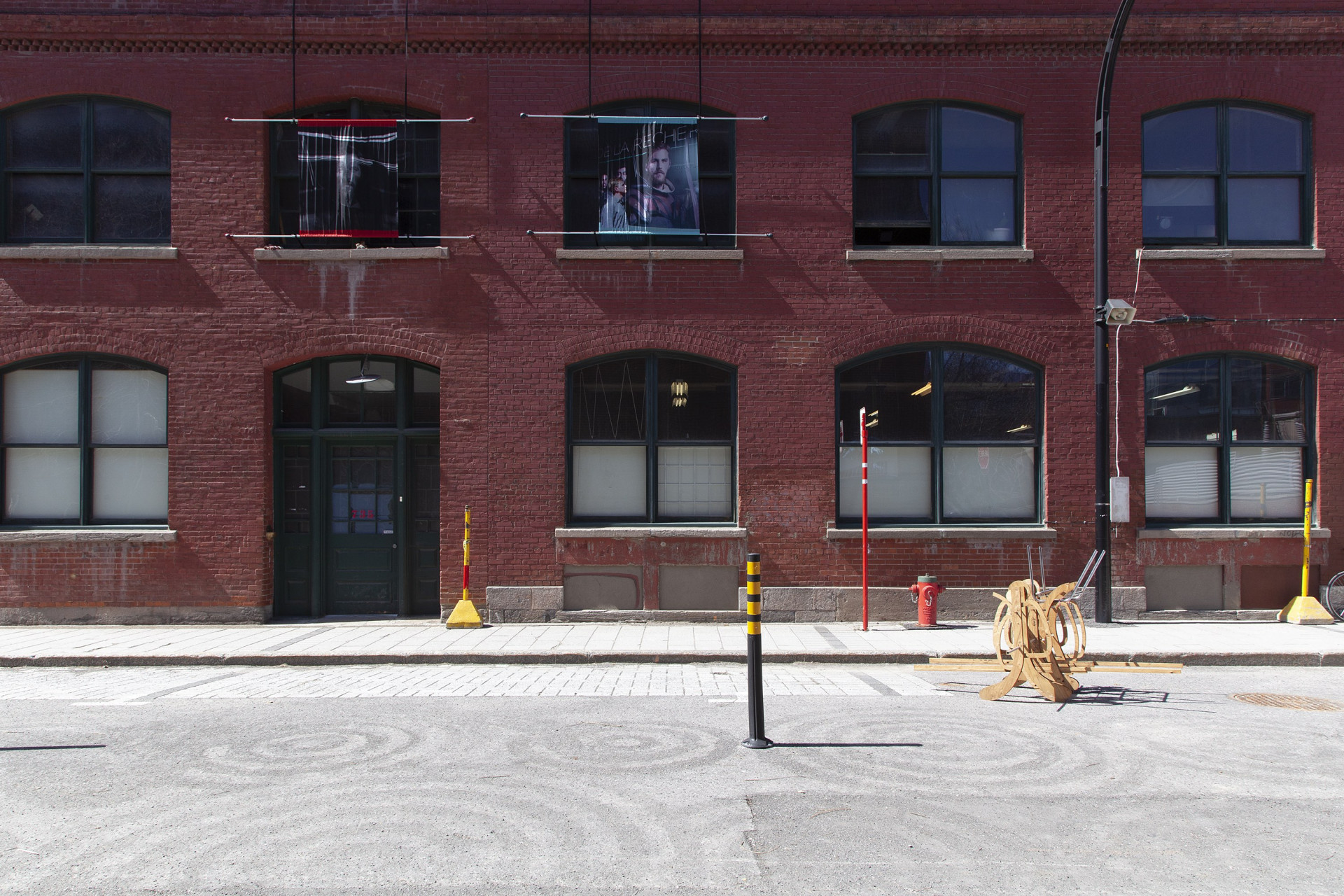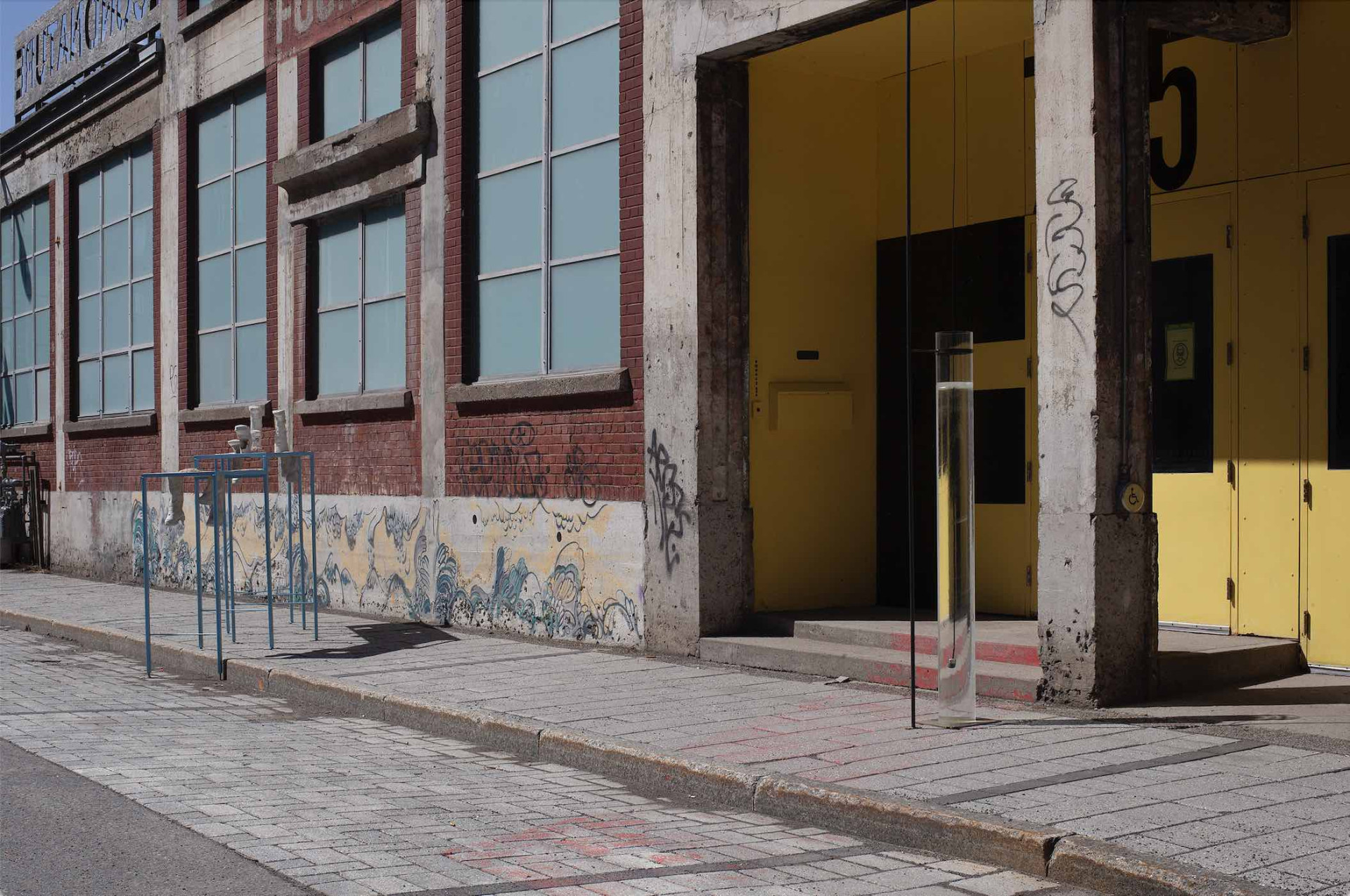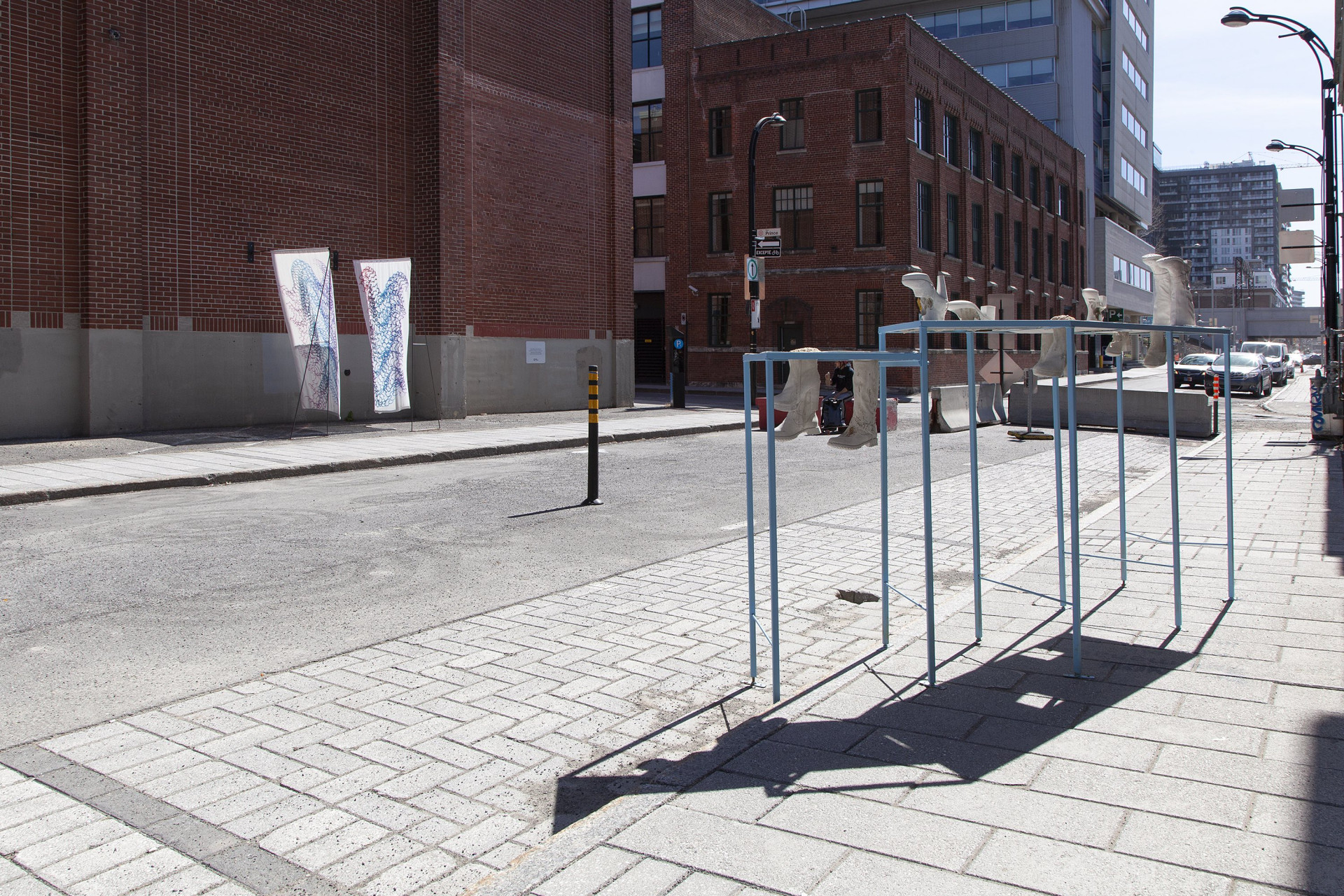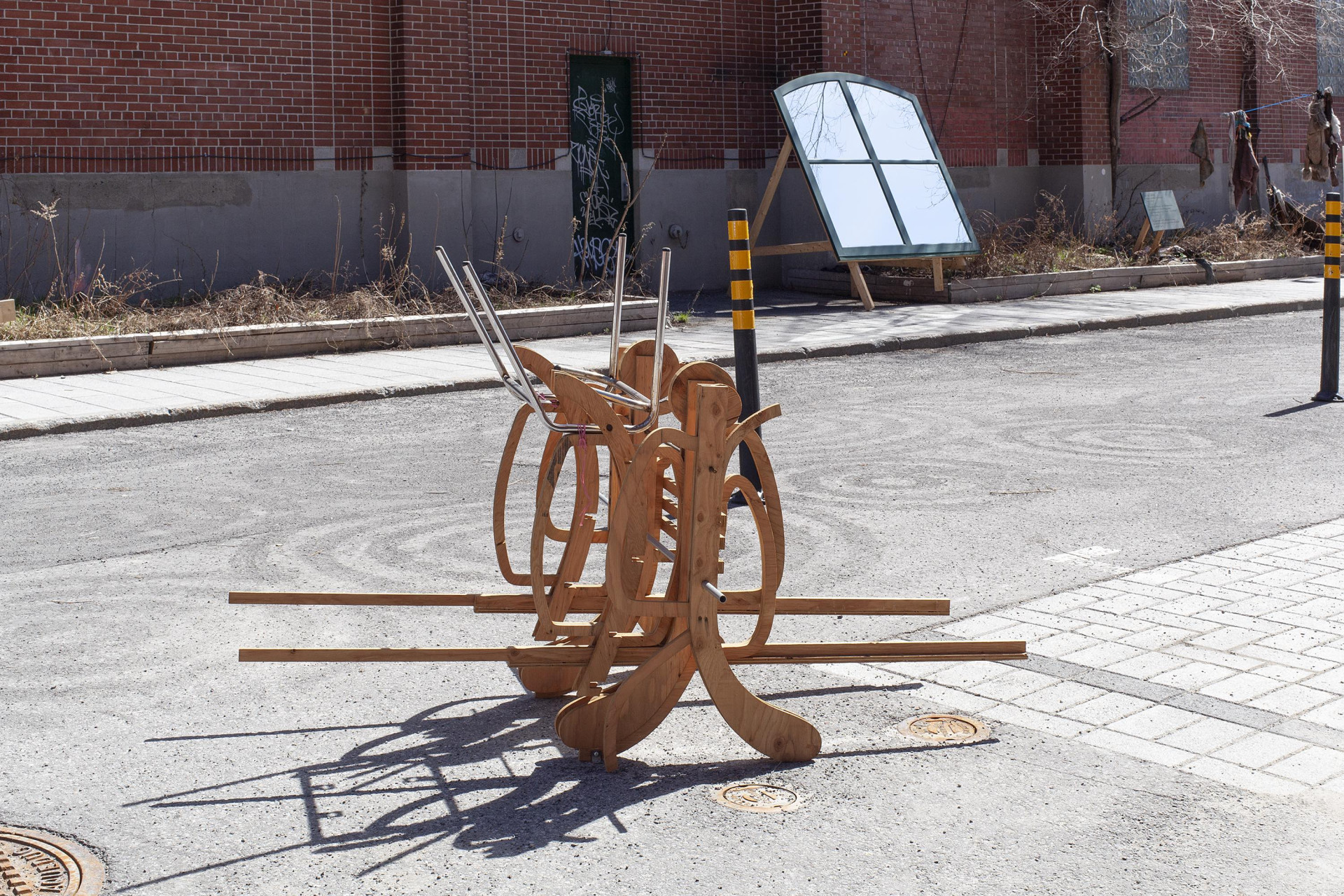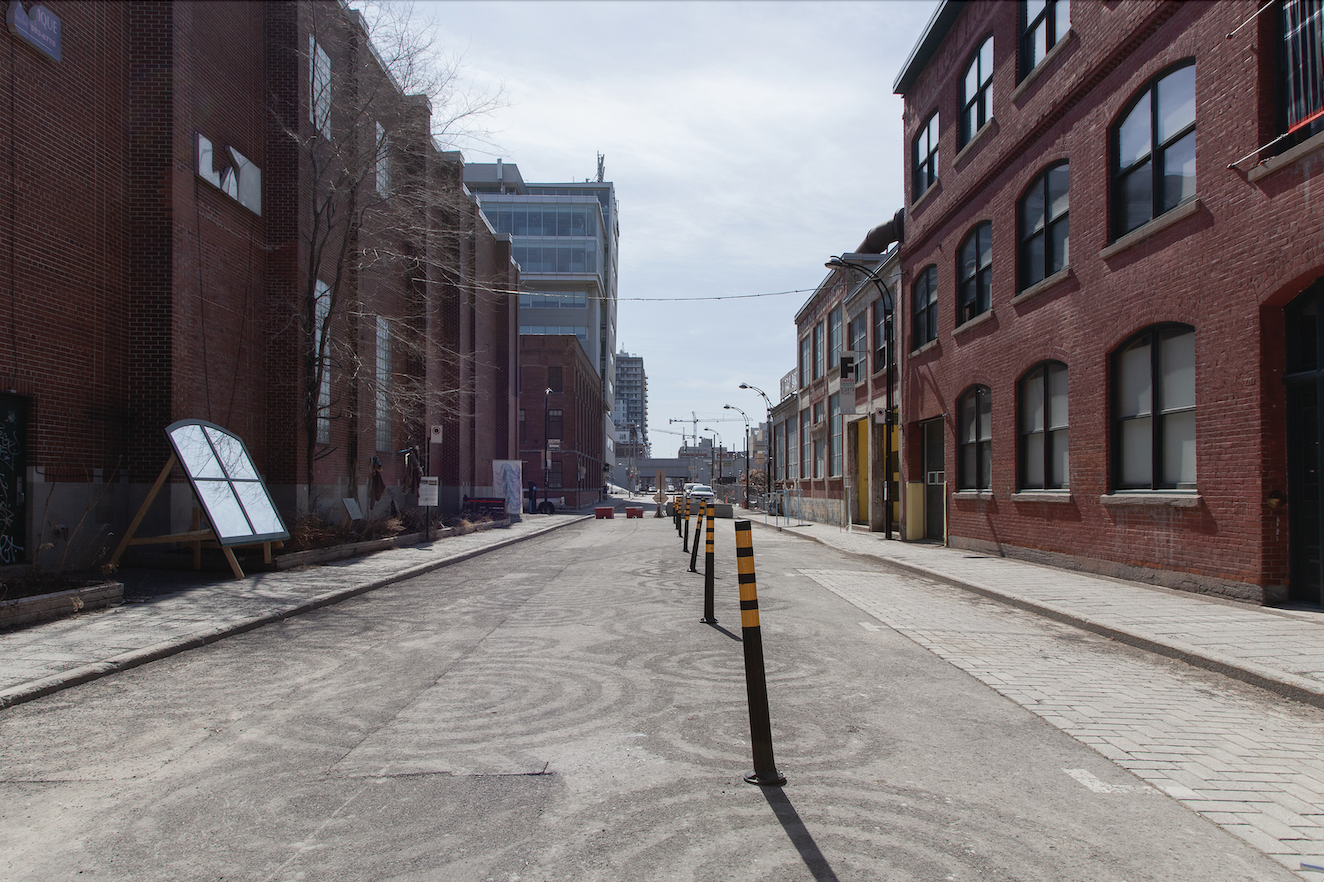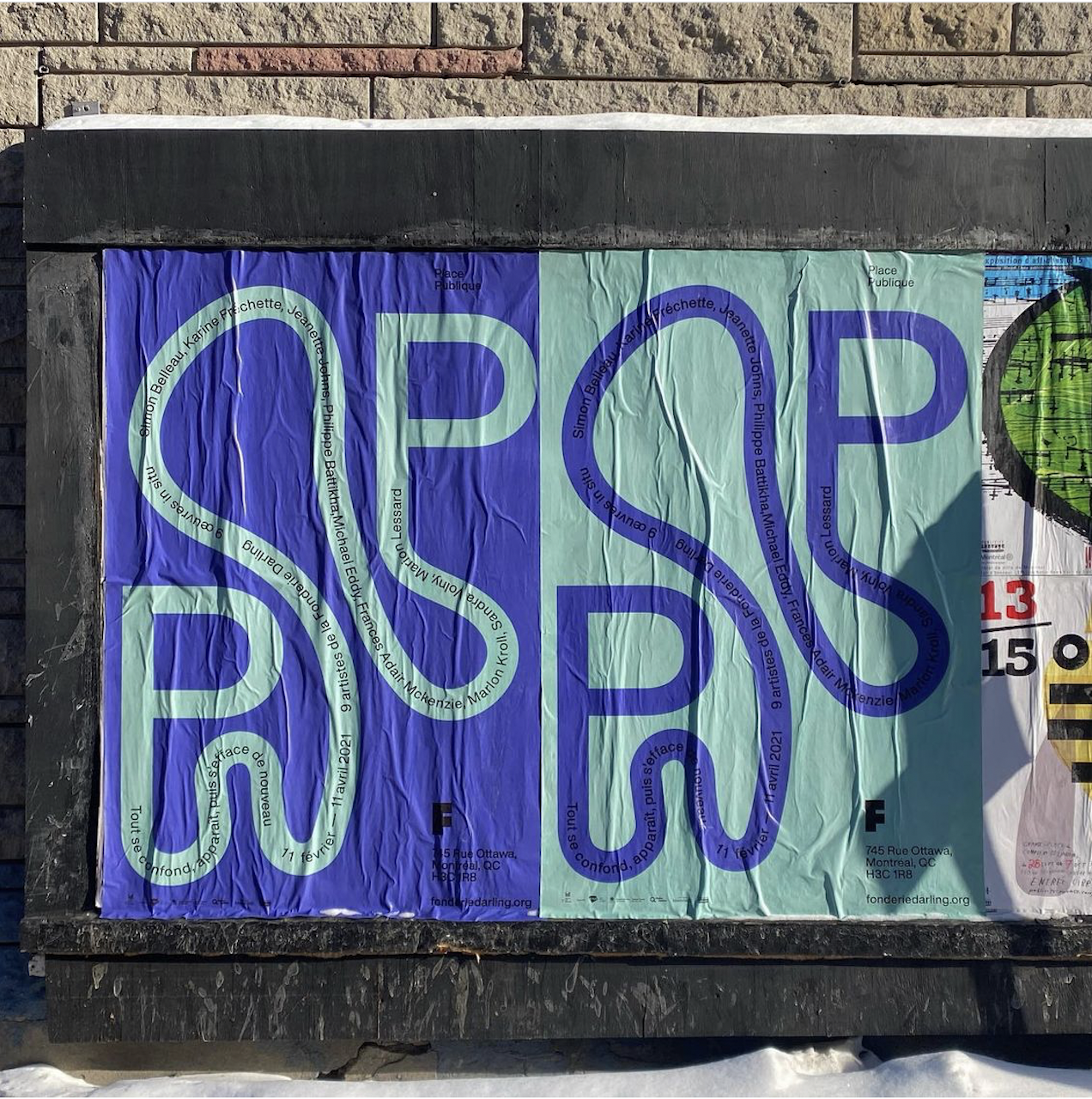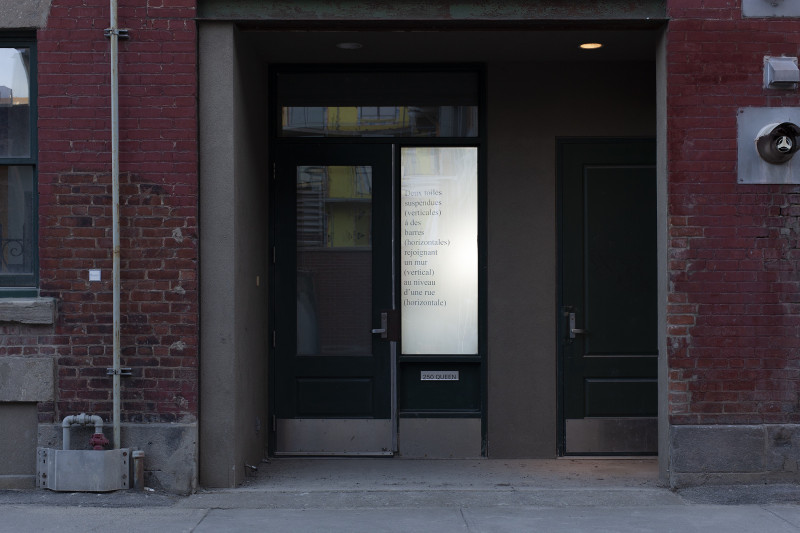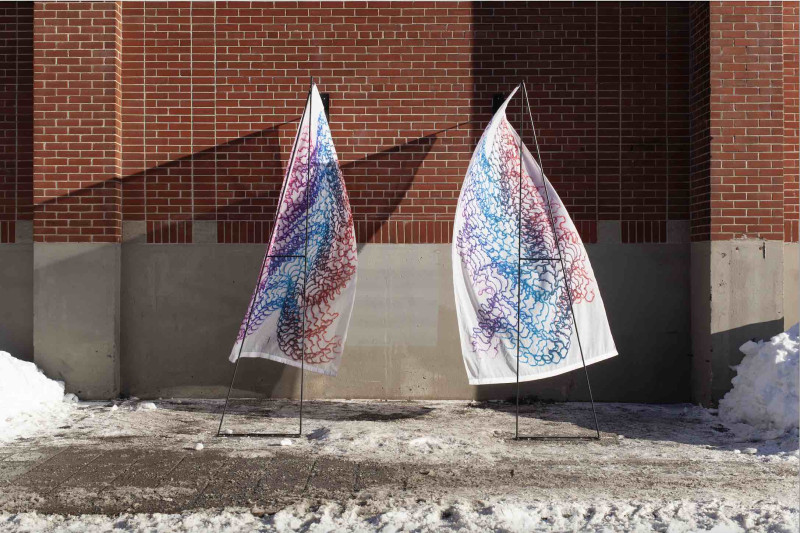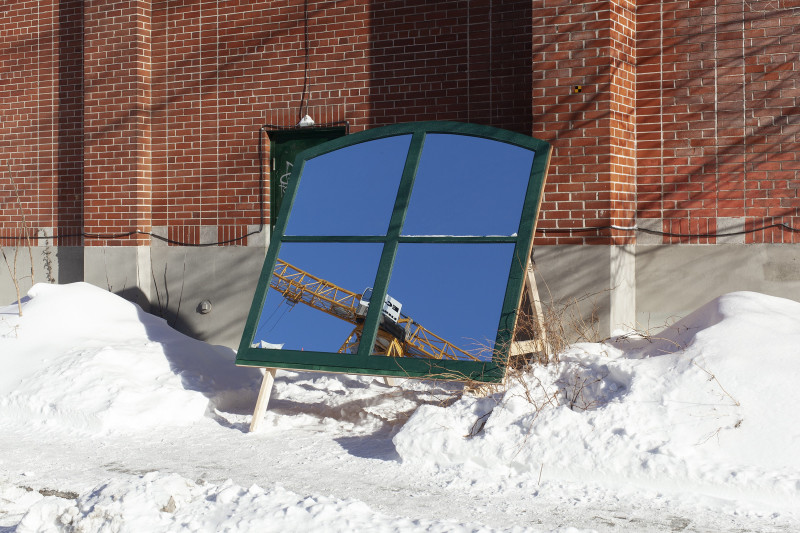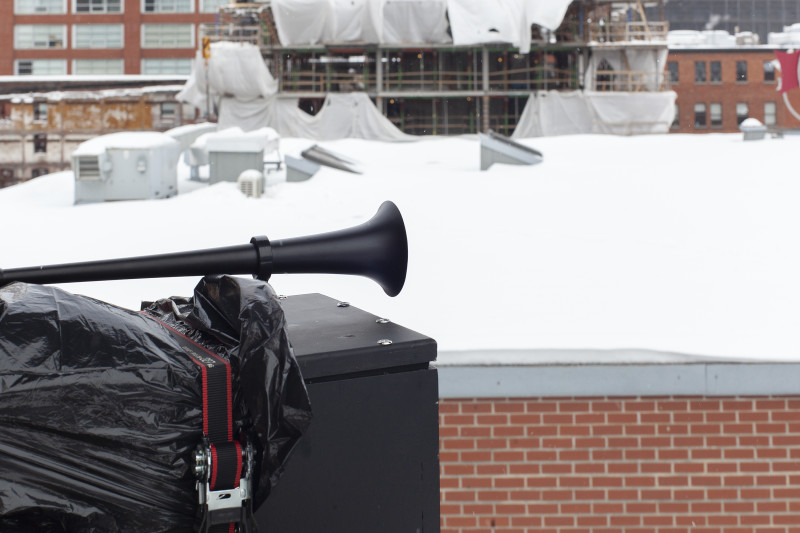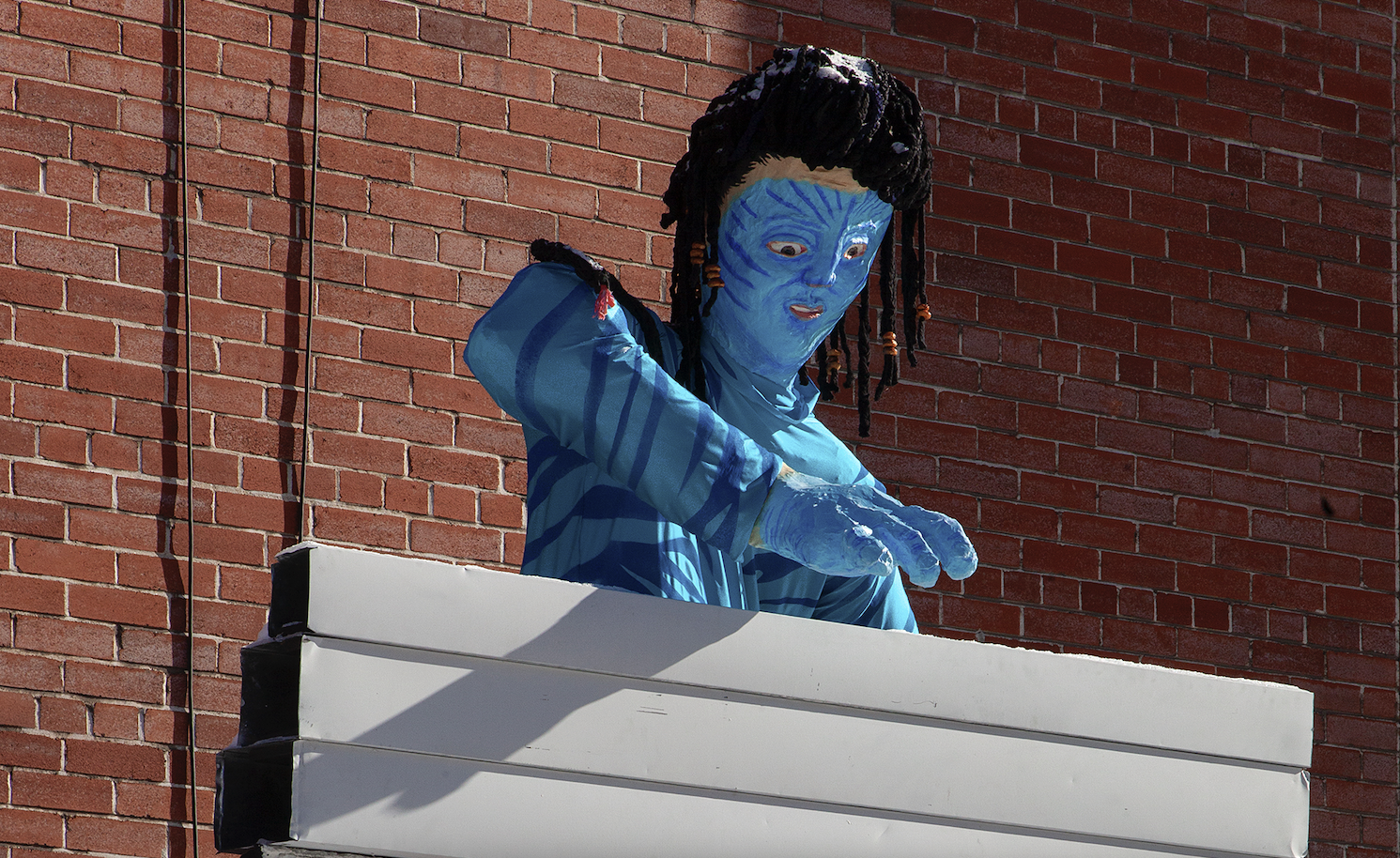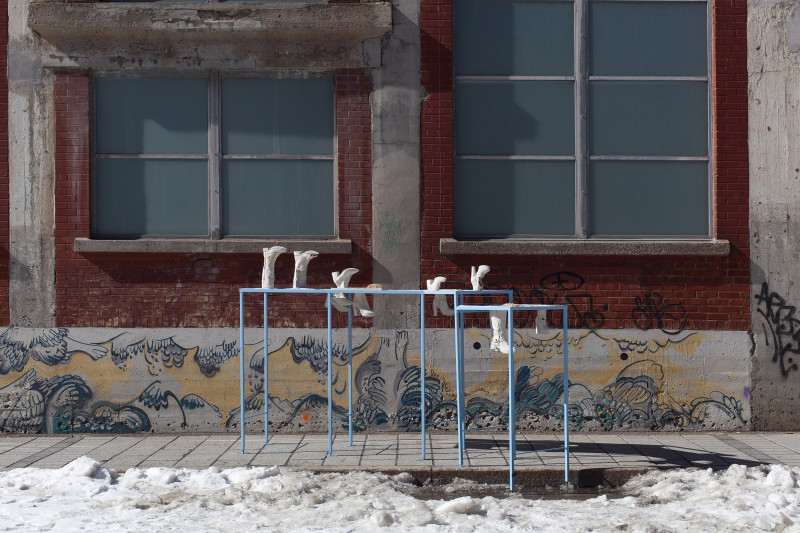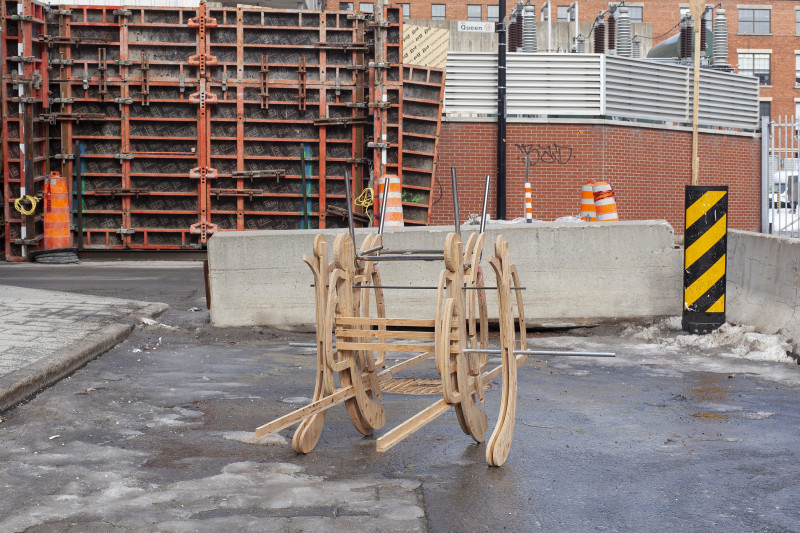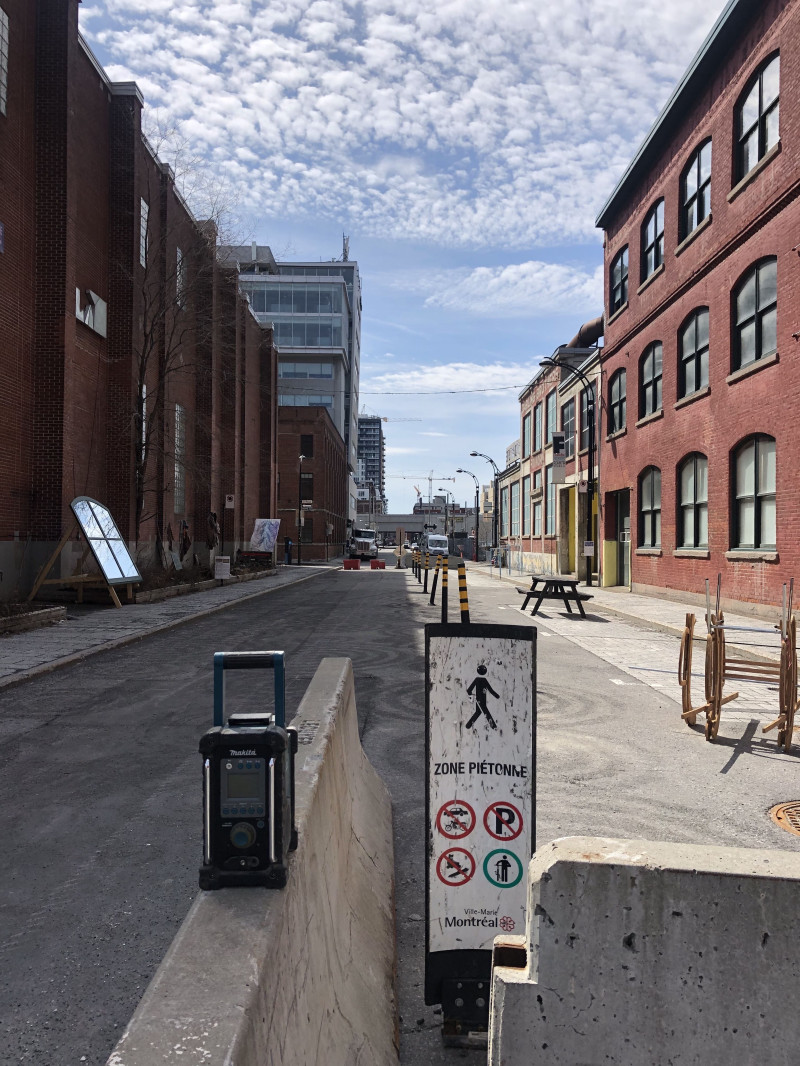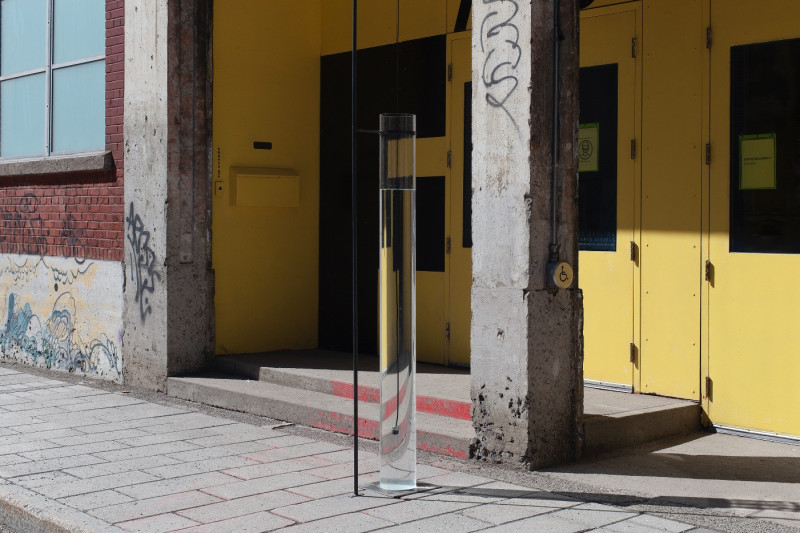TOUT SE CONFOND, APPARAÎT, PUIS S'EFFACE DE NOUVEAU
[Everything Merges, Emerges, then Fades Again]
For almost a year, the closing of museums, art centres, and non-commercial galleries has been one of the key strategies used to prevent the spread of a virus responsible for a devastating pandemic. While artworks are confined to exhibition rooms and our lives shift online to an excessive degree, the recognition of artists’ work starts being defined by an overriding condition: the dictates of a mediated hypervisibility. Ephemeral outdoor spaces open another possible AFK (away from keyboard) route to counter the online invisibility of certain practices or their too rapid absorption into the vortex of overproduction. In the current context of a sanitary and solitary winter, the Place Publique in front of Fonderie Darling’s buildings becomes a choice outdoor space of dissemination. The dire need for such spaces and their relevance is reflected in a principle that is commonly supported, now more than ever: art exists when seen.
Located on a stretch of Ottawa Street between two imposing heritage buildings, Place Publique is a hybrid art space that makes an impact: its unique layout, its purpose of integrating art into an urban context, and its activist history inspire the collective imagination and stimulate artists to constantly explore its potential. Today, except for the presence of construction workers on job sites, Old Montreal is deserted and surrounded by a ghostly aura intensified by the glacial temperatures of the early winter months. To show the appeal of Place Publique and encourage community life in the neighbourhood, it seemed urgent to revive it. Having observed the uninterrupted activity of artists in the building, it became clear that the studio remains a productive and creative space, even in times of crisis. Who better to explore Place Publique in winter than those who look upon it from the windows of their studios every day?
Everything Merges, Emerges, then Fades Again assembles nine site-specific works created by the artists in the Montreal Studios, a long-term residency program at Fonderie Darling. Video projection, spontaneous performance, sound works, and sculptural installations will steadily appear one after another to occupy the street and interstices of the building until the spring. Hidden, fleeting, or plainly visible, the various works will respond to one another sequentially, in a straight line or in reverse, at times also taking a few detours. As though tracing the lines of a constellation, the artists respond to questions of renegotiated space and suspended time, while surveying the structure of our interior architectures; their voices vary between different positions—dystopia, detachment, dissent, or fantasy—revealing our many complex relationships to reality. Whether walking in the area by chance or on purpose, the pedestrians of Montreal are invited to make a detour and experience this route that imperceptibly leads to a process of identification and introspection.
Milly-Alexandra Dery
Translated by Oana Avasilichioaei
FOUNDRY LAUNDRY RADIO
Initiated by Philippe Battikha, WJFL107.7 FM Foundry Laundry Radio invites artists in residency at Fonderie Darling to share content on a pirate radio station, broadcast on the web. The station mixes experimental music, podcasts, performances and other sonic explorations - and regularly accepts contributions from other artists who wish to share the airwaves.
WJFL107.7 FM serves as an extension of the group show project Everything Merges, Emerges, then Fades Again; by tuning in to the same frequency, it is possible to pursue the back-and-forth between the ideas and the works, to foster moments of receptivity, feedback, and transmission. The contributions of the participants are very varied; some are directly related to the works on Ottawa Street and others are tied to the project by creating new connections. A poem, a note to the audience, a song, a phone recording, or a recording made in the field...everything is accepted, and not edited.
Feb. 11
Annotations is an evolving video work by Simon Belleau visible in a window of the 250 Queen Street entrance, around the corner from Place Publique. Over weeks, the artist annotates the works of the artists in the exhibition as he sees them emerge in the space; his notes refer solely to objects and actions, deliberately eliminating any context. A schematic rendering of the tangible and played in a loop, this rear-screen projection reproduces the form of a blank page on which short phrases scroll. Although by its very essence, an artwork inevitably prompts commentary, these abridged annotations arise from a process of deconstruction that is in stark contrast to an extolment of critical discourse. The effort to synthesize and the desire to pare down introduce the idea that time and again the visual language of art will prevail over any justifications. Annotations sets up a dialogue with the other works, evolving with a slight delay and beginning when the first work is installed in the space and ending when the eight work and its annotation close the parenthesis.
Feb. 13
While words allow us to reduce a work to its simplest expression, the filtering of visible phenomena reframes our experience of the world according to its most elementary geometry. A free observation of a post-Internet conception of landscape, Shadow Recorder 4V1 and Shadow Recorder 5V1 are sketches of ongoing research: How might line and colour embody the momentary experience of a moving shadow? Outside the confines of her studio, Karine Fréchette exposes two long swaths of sheer fabric to the elements, hanging them from metal structures like large flags fluttering on Place Publique. Studies of the effects of light due to variations in the solar cycle are associated with an analytical abstraction of forms and a process that emphasizes a repeated, asynchronous gesture. Methodical and meticulous, the latter allows the artist to make tangible an intangible fragment of reality, the transient experience of an opaque body intercepting light.
Feb. 17
A window’s frame encloses the field of vision; it allows us to look into the distance or, quite the opposite, secretly observe the activity taking place within. After staring out a large window that gives onto a brick wall, Jeanette Johns began wondering what was happening in her neighbours’ studios, on the other side of her studio walls. Since gatherings have been reduced as much as possible, the artist imagines another mode of connecting through a life-size reproduction of the arched window in her studio, in which she has replaced the glass by mirrors. Set on the ground and tilted to face the upper floors of the studio building, Moon as Mirror in Search for Life offers an astute mise en abyme in which the artist can observe her own and others’ reflections, guess their presence inside the building by seeing their lights on. While our current human experience is characterized by distance, Johns explores the symbolism of this mirror-window as a means of communication, reflecting that life in the studio continues in isolation and out of the public gaze.
Feb. 20
The reciprocity between the interior and exterior spaces of the studio and Place Publique is the starting point of several site-specific works of this project. Philippe Battikha extends the perimeter of the exhibition to the neighbouring streets by singling out a sound occasionally heard in Montreal, namely the whistle blast used to signal dynamite blasting. An air horn is concealed on the roof of Fonderie Darling, and the blaring sound of this device is modified to emit a warning signal in Morse code. Activated at irregular intervals, Save Our Souls creates a rupture in the urban soundscape with a gently ironic and subtly humorous gesture. Sending out the distress signal echoes the real sense of powerlessness felt by the Fonderie Darling community: How can the presence of art, artists, and cultural workers be assured in a neighbourhood beset by rampant real estate speculation? Just how long can the body tolerate to live in the middle of a perpetual construction site, surrounded by loud noises, vibrations, and debris?
Feb. 24
Two works face each other: on one side, a sculpture of the Na’vi protagonist of the blockbuster movie Avatar, and on the other, on a hanging banner, the image of an anonymous knight featured in the recruitment ads of Algorithme Pharma. On Place Publique, Michael Eddy draws a parallel between these two characters by examining the process of identifying with stories and myths, particularly through costume and personification. Neytiri and Allez au front pour la recherche refer to the manner by which certain characters become powerful tools for creating a form of fantastical militancy, experienced through fictional associations. The archetypes of the spiritual warrior and protector of her people and of the medieval hero modelled on the Jon Snow character from the hit series Game of Thrones embody the ideals of bravery and virtue that deeply resonate with the contemporary cultural imagination. In movies and advertising, the call to action—save one’s people, support medical research—gets associated with a progression from dehumanization to heroism. Entertainment, kitsch, populism, and ideology are thus intertwined; the polarization between reality and fiction gradually invades the public space and the media. Eddy’s work also reflects on his own experience at Fonderie Darling, a place that sometimes takes on the qualities of an isolated fortress in the middle of the Cité du Multimédia. While Ottawa Street has been the stage for much antagonism over the past decade, the artist imagines Place Publique as a mythical place, symbolizing a position of resistance against the transformation of an industrial neighbourhood into a neoliberal space.
March 05
An awareness of the site inevitably guides the artists’ reflections and explorations in Place Publique; the works subtly accumulate, branching out into narratives that have resilience, resistance, and solidarity as their common thread. Untitled with Suet 2021 (After Joyce Wieland’s Solidarity 1973) is an assemblage of footwear cast in cement, coated in suet for the birds, and attached to a metal structure painted sky-blue. Beginning on the sidewalk, then veering into the street, Frances Adair Mckenzie’s work is a reference to an experimental film by Canadian artist Joyce Wieland, which documented a strike by the workers of the Dare Cookie Factory in Kitchener, Ontario, in the 1970s. The film shows dozens of female labourers’ feet shot in close-up as they march for equal pay and decent working conditions. In contrast to the images filmed by Wieland, Mckenzie’s cast feet are undisciplined and refuse to march in step; depending on the direction in which the toes are pointing, the line sometimes breaks up and sometimes goes backwards. Only two moulds were created to make the series; like History repeating itself, the shapes recur in a loop, giving the illusion of continuity and forward movement. To restrict these movements to the sculptural frame, Mckenzie draws inspiration from video animation processes, such as the walk cycle, and the editing techniques associated with the films of Dziga Vertov and the Russian avant-garde, such as sequential assemblage and geometric abstraction. A feminist homage and ode to difference and rebellion, Untitled with Suet 2021 (After Joyce Wieland’s Solidarity 1973) revisits, in sculpture, an experimental cinematic tradition that combines social consciousness with freedom of representation.
The artist dedicates this work to Ellen & Adam & Divina.
March 12
Frigid. toppled, toes to bar, drag me across snow down mountain road stems from Marlon Kroll’s current obsession with the human body’s defence mechanisms and capacity for self-regulation that makes it possible to associate it with a self-propelled machine. Exploring sculptural forms that evoke the skeleton, skin, and organs, the artist revisits the physiological structures filtering the micro-aggressions of the immediate environment and protecting our fragile interior. For the group exhibition Tout se confond, apparaît, puis s’efface de nouveau [Everything Merges, Emerges, then Fades Again], Marlon Kroll has created a hybrid object that embodies the duality between the biological and the industrial. From afar, the object seems to shape the familiar form of a sled or a snowplough’s front loader, while from up close, it evokes the contours of a rib cage; the wood cut-outs are as clean, curved, and precise as bones. The artist imagines a crossbreed between the bone structure that protects the heart and lungs and an aggressive piece of machinery that is essential to winter urban life. The association creates a sense of suffocation that makes us deeply aware of our materiality. Within the scope of the exterior and evolving intervention on Place Publique, Marlon Kroll alludes to the many compromises that the body makes daily to survive, at the risk of suffocating.
March 15
While the first sound intervention of this exterior group exhibition emits a deafening noise derived from nearby construction sites, Sandra Volny’s work explores sounds that exist at the limit of the audible, elements that are almost imperceptible to hearing. La passeuse is a listening instrument and part of the artist’s research into our perception of acoustic space and the residual traces of our sensory environment. Visually, the installation echoes the architecture of Fonderie Darling: the metal rod stands out like a banner and a large tube of transparent acrylic plastic filled with water hangs from the building like an extension of it. A hydrophone is immersed in this elegant and mysterious object to collect acoustic data, such as the reverberations against the walls when cement trucks pass by or the vibrations of the ground trembling under pedestrians’ feet. Depending on the fluctuations in spring weather, these residual sounds are recorded through the filter of the water, which sometimes turns into ice, then transmitted via a loudspeaker located on the corner of Ottawa Street. The resonances accumulate in layers, attesting to their persistence in the background of the public space. By allowing the sound to pass from one context to another and asking us to listen carefully to the soundtrack of our daily lives, Volny traces an inverse acoustic image of Ottawa Street and amplifies the negative of our sensory space. La passeuse thus records the sonic DNA of Place Publique, receiving the muffled sounds of our environment and engulfing them to then retransmit them to our ears with amplified density.
The artist would like to thank the Conseil des Arts et des Lettres du Québec, Fonderie Darling, Simon Bélair, Sarah Baldous.
The final proposition of this group exhibition, Ça et là is by the Marion Lessard collective and is based on a stream of observations of Place Publique. Negotiating an effect of distance and proximity, the collective will offer commentaries and descriptions on the works installed on Ottawa Street and the day-to-day occurrences happening there. This approach, which accounts for uncertain presences and unpredictable absences entails a paradoxical gesture: that of speaking out without expecting to be heard. The comments, thoughts, and reactions of the Marion Lessard collective will be broadcast live via an old jobsite radio and retransmitted online, with a time delay of a few seconds, on WJFL 107.7 FM, the pirate radio station of the Fonderie Darling artists. An act of projection and attribution, the work takes up an indiscernible position where interior and exterior merge and where live, recorded, and broadcast voices succeed each other. Through these contradictions, Ça et là disorients listeners, confounds expectations by the very act of making us wait, and helps us to imagine a form of withdrawal.
While Everything Merges, Emerges, then Fades Again began with a sequence of annotations in rear projection, the exhibition ends with a series of comments, descriptions, and observations spoken out loud in the public space and on the web. This intervention closes the loop, in both space and time, by commenting on the things that are fading from the street before they’ve even had time to form clearly in our minds. Up to its last throes, this project, which calls for responses, rebounds, and ricochets, will be marked by the inevitable distance of interactions, the lag-time of exchanges, and by unique trajectories that ultimately bring us back to the starting point.


